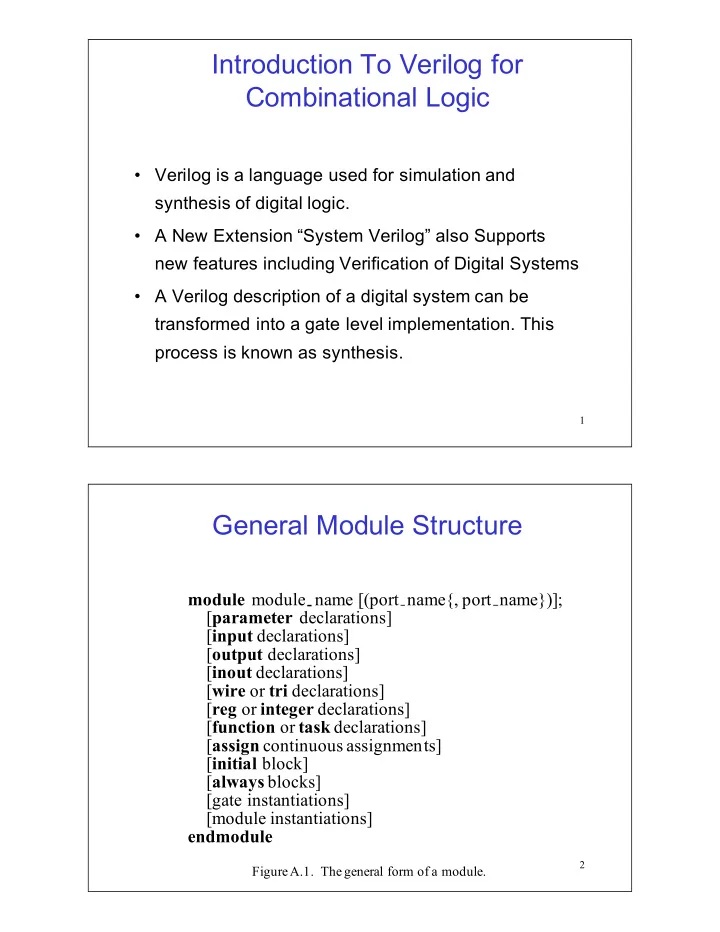

Introduction*To*Verilog*for* Combinational*Logic • Verilog*is*a*language*used*for*simulation*and* synthesis*of*digital*logic. • A*New*Extension*“System*Verilog”*also*Supports* new*features*including*Verification*of*Digital*Systems • A*Verilog*description*of*a*digital*system*can*be* transformed*into*a*gate*level*implementation.*This* process*is*known*as*synthesis. 1 General*Module*Structure module module name [(port name{, port name})]; [ parameter declarations] [ input declarations] [ output declarations] [ inout declarations] [ wire or tri declarations] [ reg or integer declarations] [ function or task declarations] [ assign continuous assignmen ts] [ initial block] [ always blocks] [gate instantiations] [module instantiations] endmodule 2 Figure A.1. The general form of a module.
Verilog(Statements • We will only examine a subset of the language – RTL – Synthesizable Portion • Some Verilog constructs: – Signal Assignment: assign A = B ; – Comparisons == (equal), > (greater than), < (less than), etc. – Boolean operations & (AND), | (OR), ~ (NOT), ^ (XOR) – Concurrent statements • Gate Instantiations: and u1 (X, A, B); • Continuous Assignments assign S = X & Y; – Procedural (Sequential) statements • Evaluated in order in which written • Must be Contained in an always or initial block 3 Some*Verilog*Syntax • Approximately*100*keywords*(lowercase) – Verilog*IS*caseNsensitive – Predefined*identifiers*Used*for*Basic*Language* Constructs • Comments*are: – // to*end*of*line – /* comment here */ • Simulator*Directives – Technically*not*part*of*language,*but*Standard – Begin*with*a* $ – Example* $finish; • Simulator*Directives*not*used*for: – Documentation – Synthesis 4
Verilog*Keywords*(part*1) 5 *excerpt from IEEE 1364-2005 standard for academic use only Verilog*Keywords*(part*2) 6 *excerpt from IEEE 1364-2005 standard for academic use only
Some*Verilog*Operators Reduction*Operators Arithmetic*Operators negation ~ unary*(sign)*plus + bitwise*AND & unary*(sign)*minus - bitwise*OR | binary*plus*(add) + bitwise*NAND ~& binary*minus*(sub) - bitwise*NOR ~| multiply * bitwise*XOR ^ divide / bitwise*XNOR ~^ modulus % bitwise*XNOR ^~ Logical*Operators logical*negation ! logical*equality == logical*inequality != logical*AND && logical*OR || 7 Verilog*Values*and*Constants Constants Four*Basic*Values integers logicN0*or*false 0 reals logicN1*or*true 1 strings unknown*value x highNimpedance*(open) z _*can*be*embedded ( z at*input*usually*treated*as* x ) Specifying*Values Simple*Decimal int,*real Base*Format*Notation int Scientific real Double*Quotes strings 8
Base*Format*Notation*Examples Format*is: [size (in bits)]’base value 5Nbit*octal 5’O37 4Nbit*decimal 4’D2 4Nbit*binary*(underscores*“_”*ignored) 4’B1x_01 7Nbit x ( x extended) 7’Hx xxxxxxx 4Nbit z ( z extended) 4’hZ zzzz ILLEGAL:*value*cannot*be*negative 4’d-4 spaces*allowed*between*size*and ‘ 8 ’h 2A and*between*base*and*value 9Nbit*octal ’o721 8Nbit*hex ’hAF 10Nbit*padded*to*left 10’b10 0000000010 10Nbit*padded*to*left 10’bx0x1 xxxxxxx0x1 same*as 3’b011 3’b1001_0011 same*as 5’H1F 5’H0FFF 9 Verilog*Data*Types • Net*Types*(eg.* wire ) – Represents*Physical*Connection*Between*Structural* Elements – Value*is*Determined*from*Value*of*Drivers • Continuous* assign Statement • Output*of*Gate*or*UDP*(User*Defined*Primitive) • If*no*Driver*is*Present,*Defaults*to*value*of* z • Register*Type*(eg.* reg ) – Abstract*Data*Storage*Element – Assigned*Values*Only*within* always or* initial statement – Does*not*ALWAYS*synthesize*to*storage*device – Value*is*Saved*from*one*Assignment*to*the*Next 10 – Default*value*is* x
Verilog*Data*Types • Net*Types N most*common,*default*is*z wire, tri N emulates*wiredNOR*with*mult.*drivers*(ECL*NOR) wor, trior N emulates*wiredNAND*with*mult.*drivers*(OCNTTL*NAND) wand, triand N stores*a*value*like* reg for*modeling*capacitive*nets trireg tri1, tri0 N default*values*are*1(0) supply0,supply1 N used*to*model*power*connections*for*0*and*1*values • Register*Type N most*common,*default*is* x reg N used*for*storing*integers,*typical*use*in*behavioral*model integer N used*for*storing/manipulating*time*values time N used*storing*reals,*typical*use*in*behavioral*model real realtime N same*as*real 11 4NValued*Net*Fanin*Tables • Two*Names*for*Same*Data*type 12
Wired*Nets • Used*to*Model*Wired*Logic • Assumes*Equal*Strength*Drivers 13 Driver*Strength • Not*Used*in*this*Class*for*Synthesis*Purposes • Created*for*Accurate*Modeling*of*Devices*Such*as: – signal*contention – bidirectional*pass*gates – resistive*MOS – dynamic*MOS – charge*sharing strength0*part*of*net: • supply0 strong0 pull0 weak0 highz0 strength1*part*of*net: • supply1 strong1 pull1 weak1 highz1 In*contrast*to*9Nval.*logic*IEEE*std*1164*as*used*in*VHDL • 14
Busses*and*MultiNbit*Registers • Can*use*“arrayNtype”*Notation • Examples: wire [2:0] Bname // A 3-bit bus called Bname reg [7:0] Accumulator // An 8-bit register named Accumulator • Suggestions – Always*number*from*MSb*to*LSb – Matches*the*Radix*Power*in*Radix*Polynomial – Consistency*Helps*to*Avoid*Bugs 15 Busses*and*Instantiation 16
Verilog*Logic*Gate*Primitives Name Description Usage and f = ( a · b ) and ( f , a , b ,…) ··· nand f = nand ( f , a , b ,…) ( a · b ··· ) f = ( a + b + ) or ··· or ( f , a , b ,…) nor f = ( a + b + ) nor ( f , a , b ,…) ··· ) xor f = ( a ⊕ b ⊕ ··· xor ( f , a , b ,…) xnor f = ( a ! b ! ) xnor ( f , a , b ,…) ··· not f = a not ( f , a ) f = a buf buf ( f , a ) notif0 f = (! e ? a : ' bz ) notif0 ( f , a , e ) notif1 f = ( e ? a : ' bz ) notif1 ( f , a , e ) buf0 f = (! e ? a : ' bz ) buf0 ( f , a , e ) buf1 f = ( e ? a : ' bz ) buf1 ( f , a , e ) 17 Table A.2. Verilog gates. Example // Combinational Logic Circuit module maj_circ(Y, A, B, C); input A, B, C; output Y; and U1 (x1,A,B); and U2 (x2,A,C); and U3 (x3,B,C); or U4 (Y,x1,x2,x3); 18 endmodule
User*Defined*Primitives*(UDPs) • Keywords* and ,* or ,* not ,* xor ,*etc.*are*System* Primitives • Can*Define*your*Own*Primitives*(UDPs) • Can*do*this*in*a*variety*of*ways*including*Truth* Tables • Instead*of* module / endmodule use*the*keywords* primitive / endprimitive • Only*one*output*and*must*be*listed*first • Keywords* table and* endtable used • Input*values*listed*in*order*with*a* : • Output*is*always*last*entry*followed*by* ; 19 UDP*Verilog*Example // User defined primitive (UDP) primitive crctp (x, A, B, C); output x; input A, B, C; // Truth table for x(A,B,C)= Σ (0,2,4,6,7) table // A B C : x (note: this is a comment) 0 0 0 : 1; 0 0 1 : 0; 0 1 0 : 1; 0 1 1 : 0; 1 0 0 : 1; 1 0 1 : 0; 1 1 0 : 1; 1 1 1 : 1; endtable endprimitive // Instantiate primitive module declare_crctp; reg x,y,z; wire w; crctp (w, x, y, z); endmodule 20
Boolean*Expressions*in*Verilog • Use*the*Continuous*Assignment*Statement – Keyword*is* assign – Boolean*Operators*(normal*precedence): & N AND | N OR ~ N NOT*(invert) – When*in*Doubt*about*Precedence*Use* Parentheses • Previous*Example*as*Expression: assign x = (A & B) | (~C); 21 Verilog*Assignment*Statements 22
Assignment*Statement*Ordering Sequential*Language Event*Driven*Language N Program*Counter N Event*Queue or*Instruction*Pointer N Dynamic*Execution 23 N Static*Execution Verilog*Example A x B Circuit Being C Modeled y D // Circuit specified with Boolean expressions module circuit_bln (x, y, A, B, C, D); input A,B,C,D; output x,y; assign x = A | (B & C) | (~B & D); assign y = (~B & C) | (B & ~C & ~D); endmodule 24
Assignment*Statement*Problem 25
Recommend
More recommend